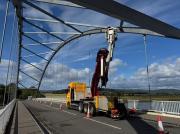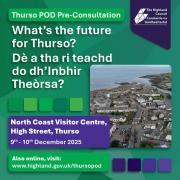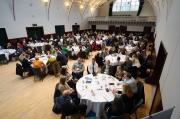Highland Council issues a statement setting out its position on the EU
1st July 2016
The HIGHLAND Council on Thursday 29th June 2016 considered the impact of last Thursday's vote for the UK to leave the European Union.
Members noted the expected implications for Highland of the UK decision to leave the European Union and agreed to meet as appropriate to consider possible scenarios and initiate contingency planning.
The following statement from the Council was agreed by Members.
"Highland Council believes that the Highlands is a well educated, innovative and resilient area and is open to business and new business opportunities.
"We will carefully monitor developments as the withdrawal from Europe begins and will demonstrate leadership for our communities as we plan and prepare for our future.
"Highland Council wishes to reassure everyone of all cultures, races and communities that they are valued members of our Community and we will continue to welcome migrants into Highland.
"This Council will endorse and support the endeavours of the Scottish Parliament to maintain and protect Highland's and Scotland's position within the European Union."
Leader of the Council, Councillor Margaret Davidson said:"The result of the referendum on Thursday will have considerable consequences for us all over the coming months and years. This paper sets out some of the current European funding we benefit from as well as a number of risks and impacts.
"We will be working as a Council to explore what this decision might mean for the Highlands and how we can best respond to that.
“We need to promote confidence and be as positive as we can be. The drop in sterling will indeed mean it will be easier for Highland businesses to export and for foreign tourists to come and visit the Highlands."
She continued: “Council business and services will continue as usual and we will endeavour to provide as much stability as we can during the uncertain times ahead. We will do what we can, working with the Cities Alliance and community planning partners, to prepare for the future."
The paper discussed can be viewed on the Council website: http://www.highland.gov.uk/download/meetings/id/70496/additional_urgent_item_uk_european_referendum_and_its_implications_for_highland
UK European referendum and its implications for Highland
Report by Chief Executive and Director of Development and Infrastructure
Summary
This report attempts to identify some of the impacts that are likely to arise from the
UK decision to leave the European Union. It describes a number of areas where
Highland is supported financially by the UK's membership of the European Union.
1. Introduction
1.1 The result of the 23 June referendum has seen a majority vote in favour of the
UK leaving the European Union (EU). The formal process of leaving the EU is
triggered by the UK government invoking Article 50 of the Lisbon Treaty,
thereby commencing a period of formal negotiation of the terms of
withdrawing. Membership of the EU would then cease from the date of entry
into force of the withdrawal agreement, or failing that, two years after the
notification, unless there is unanimous agreement with EU members to extend
this period. While there is no legally defined timescale as to when (or indeed
how) the UK government should invoke article 50, indications are that this
would happen in autumn 2016 meaning the UK would leave the EU before the
end of 2018.
2. Impact Analysis
2.1 The referendum result will clearly have an impact on the people, communities
and businesses of the Highlands as well as on the Council and its public
sector partners. In the current rapidly evolving situation it is impossible to be
specific about what all these impacts will be but a number of areas where the
impacts could be significant are detailed in this report and appendices.
2.2 The report at Appendix 1 is a Briefing by the Association for Public Sector
Excellence (APSE). It is specifically focused on implications for local
government and highlights issues which will be of particular reference to our
sector.
2.3 The report at Appendix 2 has been prepared by Ernst Young LLP and offers
broader insights into process, timetable, key drivers and government policy.
2.4 Members will recognise that while these reports are informative they pose
more questions than they answer. The answers will develop over the coming
weeks, months and indeed years.
3. European Funding Issues
3.1 The Highland area and the Council itself benefits from European Structural
Investment Fund (ESIF) programmes. Highland gains some benefit from a
number of national programmes but more significantly is the beneficiary of a
number of programmes delivered at a Highland or Highlands and Islands
level. These ESIF programmes comprise the:
• European Regional Development Fund (ERDF)
• European Social Fund (ESF)
• European Agriculture Fund for Rural Development (EAFRD)
• European Maritime and Fisheries Fund (EMFF)
Allocations are made for the Highlands & Islands and for ERDF and ESF
these are quoted in Euros as the partnership agreement between the EU and
then UK underpinning these are in Euros. Once these allocations are
translated into specific Scottish Government programmes they are converted
into sterling and Lead Partners enter into contracts with the amount committed
quoted in Sterling. In recognition of the current volatile exchange rates, figures
quoted in this report follow this protocol to avoid giving misleading figures.
Appendix 3 details the levels of funding which are involved.
3.2 The European Regional Development Fund helps fund initiatives such as
business support, financial instruments (loans, guarantees etc.), low carbon,
green travel, waste reduction and IT including the rollout of next generation
Broadband. There is an allocation of €141m for this programme in the
Highlands & Islands.
3.3 The European Social Fund helps fund initiatives such as vocational training,
employability measures and poverty reduction. There is an allocation of €51m
for this programme in the Highlands & Islands.
3.4 The European Agriculture Fund for Rural Development provides agriculture
support and support for rural development including LEADER. EAFRD is
delivered as the Scottish Rural Development Programme (SRDP) and has no
specific Highlands & Islands allocation. There is an allocation of £8.8m for the
LEADER programme in Highland with a further allocation for the Cairngorm
National Park.
3.5 The European Maritime and Fisheries Fund supports measures for the fishing
industry, port infrastructure and community development. EMFF is a UK wide
programme, again with no specific allocation for the region. However, the
Community Led Local Development (CLLD) element has an allocation of
£0.7m in Highland.
3.6 The Highland Council is the Lead Partner for three Structural Investments
(SIs) using the above programmes :
• Business Competitiveness (Business Gateway) £ 1.18m
• Employability £10.34m
• Social Inclusion & Poverty £ 1.42m
and is in the process of applying for funding as a delivery agent in two projects
where another public sector partner is the Lead Partner. In a number of cases
the Council delivers these services through Third sector partners who would
see a negative impact if such funding was ceased.
3.7 In addition to ESIF, Highland has access to 42 other transnational and
transregional programmes and a number of these are accessed by Highland
Council or its partners. Key amongst these are:
• Horizon 2020 (the EUs Research and Innovation programme with a
budget of nearly €80 billion for 2014 to 2020) - being accessed by the
Council along with HIE and UHI;
• Erasmus+ (the European Union programme aimed at modernising and
enhancing education, training, youth work and sport) - primarily used
by the Care & Learning Service;
• Interreg - programmes to promote harmonious economic, social and
territorial development of the Union as a whole which are built around
three strands of cooperation:
⋅ cross-border (Interreg A) – For Highland this is limited to the
Programme with the ROI and NI;
⋅ transnational (Interreg B) – Includes four programmes accessible in
Highland (Northern Periphery & Arctic, North West Europe, North
Sea and Atlantic Area); and
⋅ interregional (Interreg C) – includes four Programmes under the
INTERREG V C 2014-2020 banner, all accessible to Highland.
3.8 In the short term, participation in these European funding programmes will
continue while withdrawal from the EU is negotiated. The Scottish
Government has already indicated to a number of partners that there will be
no immediate change to Scottish 2014-20 ESIF programmes and that any
funds already committed will be administered as usual. Withdrawal of any of
these funding programmes in future would have a significant detrimental effect
on Highland.
3.9 In addition to the above funding programmes which essentially support “one
off projects", agricultural businesses including farms and crofts are recipients
of funding through the EU's Common Agricultural Policy (CAP) payments. The
CAP implements a system of agricultural subsidies on which production and
many agricultural investment decisions depend so any withdrawal of these is
likely to be detrimental to the sector. In recent years there has also been an
increased emphasis on linking CAP payments to positive environmental
management which could also be affected with any withdrawal of funding.
4. Other Key Issues for Highland
4.1 EU nationals living in the Highlands & the Highland workforce
Highlanders have always warmly welcomed people from other countries who
choose to live and work in our area and it will be important at this time to
provide reassurance to EU nationals that this welcome continues and that we
value their contribution to Highland life.
Highland is home to a large proportion of migrant workers (and their families),
notably those from EU countries. Exact numbers are not available and while
an earlier quoted figure of 10,000 in 2011 was considered high, subsequent
growth allied with the Office for National Statistics estimate of 15,000 non UK
born residents in Highland in 2014 suggests this figure is now likely to be fairly
accurate. This diversity and the importance of EU migrants to the economy is
well illustrated by those attending a recent two day start up workshop for
Business Gateway in Sutherland - attended by 8 people there were 2 French,1
Hungarian, 1 Pole, 1 Australian and 1 Canadian as well as 1 each from
Scotland and England.
A number of sectors including agriculture, construction, fish and food
processing and hospitality have previously struggled to recruit staff at times
and in more recent years many businesses in those sectors have been
dependent on EU migrant workers. The NHS and care sector in the Highlands
are also reliant on EU and overseas workers although no precise figures exist
locally.
4.2 Inward Investment
Highland and the UK as a whole benefit from inward investment by
international companies who often use the UK as an entry point for accessing
European markets. Any changes to the single market arrangements that
introduced barriers to trade as well as economic uncertainty and currency
fluctuations could make Highland a less attractive place to invest.
4.3 Exports
A number of Highland businesses are dependent on exports with the EU being
a core market for many of them. Most notable are the Food & Drink sector –
which incorporates the whisky and salmon farming industries. Highland figures
are not available but figures for Scotland as a whole show 43.4% of exports
were to the EU (2014).
4.4 Tourism
Levels of inbound tourism to the Highlands are influenced by a number of
factors including exchange rate variations. Should the current situation of a
weaker pound continue the most likely outcome would be an increase in the
number of overseas visitors and an increase in domestic visitors who would
now find it more expensive to travel overseas. The perception that the
referendum result might give as to how welcoming a place the UK is, may
however negatively impact on the number of European visitors. Bearing in
mind the fact that international visitors are considerably higher spenders that
domestic visitors, any future reduction in international visitors could still have a
detrimental effect.
4.5 Procurement
The Highland Council is in the process of tendering for the delivery of services
funded by European programmes and further tenders are expected for future
activity. Uncertainty over the time EU funding programmes will cease in
Scotland creates a further level of risk in entering into any such contracts that
will require to be managed.
4.6 Impact on Partners
The Council's public sector partners benefit to varying levels from EU funding,
networks and the free movement of labour. Each will no doubt be reviewing
the impact of Brexit on their interests and it will be helpful to use the forum of
the Community Planning Board to develop a comprehensive analysis of the
overall impact on the Highlands.
5. Next Steps
5.1 At this stage it is recommended that the Leader invites interested Members
and key Officers to an early meeting to consider possible scenarios and
initiate the development of contingency plans to mitigate the most significant
risks. Follow-up meetings can be convened on an ad-hoc basis.
Recommendations
Members are invited to note the expected implications for Highland of the UK
decision to leave the European Union and to meet as appropriate to consider
possible scenarios and initiate contingency planning.
Appendix 1
Briefing by the Association for Public Sector Excellence (APSE)
Brexit: Implications for Local Government
Related Businesses
Related Articles
Exciting Career Opportunities With The Highland Council Now Open For Applications
# 10 December 2025 Career opportunities with The Highland Council The Highland Council is looking to fill a variety of posts relating to civil engineering and flood risk management based in locations across the area. Included are opportunities specifically for civil engineering graduates and technicians, providing the ideal job with career progression for anyone recently qualified and ready for a varied and interesting role.
What the NC500 Research Projects Are Designed to Do - and Why They Matter for the Highlands
As the North Coast 500 approaches its tenth anniversary, it has become one of Scotland's most well-known tourism success stories. The 516-mile loop around the far north of the Highlands has been celebrated internationally, marketed as a world-class road trip, and credited with transforming visitor numbers in some of Scotland’s most remote areas.Help Shape the Future of Thurso
The Highland Council is inviting people that live, work, or study in Thurso, to come along to the public consultation events to have their say. This is an opportunity to help shape the future of Thurso, to gather views and ideas.
Are Scottish Councils Quietly Reversing Outsourcing? A Look at Insourcing, Cuts and the Highland IT Shift
A notable article in the Guardian on 6 December 2025 noted the high sums being paid by London councils outsourcing services to private firms. The article starts with the reduction in council funding by UK government since 2010.Council welcomes Visitor Levy flexibility plan
The Highland Council welcomes moves by the Scottish Government to introduce greater flexibility on how it could design a Visitor Levy Scheme for consultation. The Visitor Levy (Scotland) Act 2024 currently provides local authorities with discretionary powers to implement percentage-based levies following statutory consultation.Highland Council is reaching out for views to shape its next 26/27 budget.
As it looks to set out its forthcoming priorities, the council is seeking involvement from members of the public, including businesses, community groups, parents, and young people. All their opinions are going to be crucial in deciding how Highland Council will take on its budget challenge for 2026-2027.Have your say in Thurso's future £100million investment by attending public consultation events
Thurso is to benefit from £100m investment in education and community facilities and are rolling out the first phase of public consultations on 9 and 10 December 2025. The Highland Council is inviting people that live, work, or study in Thurso, to come along to the public consultation events to have their say; this is an opportunity to help shape the future of Thurso, to gather views and ideas.Finding new owners for empty homes - Scheme launched to help return more empty homes to active use
A new online portal has been launched to bring empty homeowners together with prospective buyers or developers with the aim of facilitating more properties to be used as homes again. Covering the whole of Scotland, this builds on the success of local pilots, referred to as "matchmaker schemes".Consideration for short term let control area in Skye and Raasay
Steps towards introducing a short term let control area have been considered by Highland Council's Isle of Skye and Raasay area committee. On Monday (1 December 2025) the committee heard evidence to justify the grounds for the introduction of a Short Term Let Control Area covering all or part of Skye and Raasay.Workforce North event spotlights Highland economy
EMPLOYERS and educators from across the Highlands have gathered to hear how a new initiative is aiming to transform the region's economy. Workforce North - A Call to Action brought together business leaders and teachers from primary and secondary schools from across the Highland Council area with a wide range of partners geared towards education, learning and skills development at Strathpeffer Pavillion.
